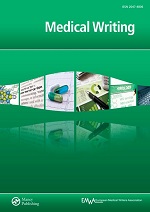
Volume 23, Issue 1 - Software for Medical Writers
Origin and development of English for Medical Purposes. Part I: Research on written medical discourse
Author: Françoise Salager-Meyer
Abstract
In this two-part review, I present the birth and growth of ‘English for Medical Purposes’, a branch of applied linguistics. This first part summarises the research conducted on English-medium written medical discourse, from early register analysis in the mid-1980s that had a clear pedagogical aim (i.e. teaching reading English-language medical discourse to non-Anglophone medical students and health professionals) to more sophisticated genre and rhetorical studies later on.
 Download the full article
Download the full article
References
- Gunnarsson BL. Professional discourse, London: Continuum; 2009.
- Cooter M. News notes. Eur Sci Editing 2000;26(2):67.
- Salager-Meyer F, Alcaraz Ariza MA, Pabón M, Zambrano N. Paying one's intellectual debt: acknowledgments in scientific/conventional and complementary/alternative medical research. In: Gotti M, Salager-Meyer F. editors Advances in medical discourse analysis: oral and written contexts. Bern: Peter Lang; 2006. p. 407–31.
- Salager-Meyer F. The core language of English medical literature: classificatory frame-work and rhetorical function. Reading Foreign Language 1983;1(1):54–64.
- Salager-Meyer F. Specialist medical English lexis: classificatory framework and rhetorical function: a statistical approach. English Medical Purposes Newslett 1985;2(2):5–18.
- Chung TM, Nation P. Technical vocabulary in specialized texts. Reading Foreign Language 2003;15:103–16.
- Ferguson G. English for Medical Purposes. In: Paltridge B, Starfield S, editors The handbook of English for specific purposes. New York: John Wiley and Sons; 2013. p. 243–61.
- Chen Q, Ge GC. A corpus-based lexical study on frequency and distribution of Coxhead's Academic Word List word families in medical research articles. English Specific Purposes 2007;26:502–14.
- Wang J, Liang SI, Ge GC. Establishment of a medical academic word list. English Specific Purposes 2008;27:442–58.
- Mungra P, Canziani T. Lexicographic studies in medicine: academic word lists for clinical case histories. Ibérica 2013;25:39–63.
- Salager-Meyer F. A text-type and move analysis study of verb tense and modality distribution in medical English abstracts. English Specific Purposes 1992;11(2):93–115.
- Salager-Meyer F. Discoursal flaws in Medical English abstracts: a genre analysis per research- and text-type. TEXT 1990;10(4):365–84.
- Salager-Meyer F, Alcaraz Ariza MA, Lewin B. Abstract quality in complementary and alternative medicine papers: a structural and cross-generic analysis. In: Bondi M, Lórez L. editors. The language and structure of abstracts: variation and change. Bern: Peter Lang; 2014, in press.
- Atkinson D. The evolution of medical research writing from 1735 to 1985: the case of the Edinburgh Medical Journal. Appl Linguistics 1992;13:337–44.
- Nwogu K. The medical research paper: structure and functions. English Specific Purposes 1997;29:43–53.
- Li L, Ge GC. Genre analysis: structural and linguistics evolution of the English-medium medical research article (1985–2004). English Specific Purposes 2009;28:93–104.
- Taavitsainen I, Pahta D. Conventions of professional writing: the medical case report in a historical perspective. JEnglish Linguistics 2000;28:60–76.
- Taavitsainen I. Medical case reports and scientific thought-styles. Rev Lenguas Fines Específicos 2011;17:75–98.
- Salager-Meyer F, Alcaraz Ariza MA, Luzardo Briceño M. The medical narrative from a diachronic perspective (1840–2009): titling practices and authorship. In: Gotti M, Sancho Guinda C. edtors Narratives in academic and professional genres. Bern: Peter Lang; 2012. p. 293–319.
- Salager-Meyer F, Alcaraz Ariza MA, Berbesí M. Collegiality, critique and the construction of scientific argumentation in medical book reviews: a diachronic approach. Journal of Pragmatics 2007;39:1758–74.
- Giannoni DS. ‘Don't be stupid about intelligent design’: confrontational impoliteness in medical journal editorials. In: Salager-Meyer F, Lewin BA. editors Crossed words: criticism in scholarly writing. Bern: Peter Lang; 2011. p. 79–98.
- Magnet A, Carnet D. Letters to the editor: still vigorous after all these years. A presentation of the discursive and linguistic features of the genre. English Specific Purposes 2006;25:173–99.
- Mungra P. Macrostructure and rhetorical moves in secondary research articles: the meta-analysis and the systematic analysis. In: Gotti M, Salager-Meyer F. editors Advances in medical discourse analysis: oral and written contexts. Bern: Peter Lang; 2006. p. 331–57.
- Salager-Meyer F, Alcaraz Ariza MA, Pabón Berbesí M. Backstage solidarity in Spanish- and English-written medical research papers: publication context and the acknowledgment paratext. J Am Soc Inform Sci Technol 2009;60(2):307–317.
- Salager-Meyer F. Hedges and textual communicative function in medical English written discourse. English Specific Purposes 1994;13:149–170.
- Ferguson G. If you pop over there. A corpus-based study of conditionals in medical discourse. English Specific Purposes 2001;20:61–82.
- Salager-Meyer F, Alcaraz Ariza MA, Zambrano N. The scimitar, the dagger and the glove: intercultural differences in the rhetoric of criticism in Spanish, French and English medical discourse (1930–1995). English Specific Purposes 2003;22:223–47.
- Salager-Meyer F, Alcaraz Ariza MA, Pabón Berbesí M. Expert knowledge holders vs. factual reporters: critical voices in written medical genres. In: Salager-Meyer F, Lewin B. editors Crossed words: criticism in scholarly writing. Bern: Peter Lang; 2011. p. 173–202.
Search
Articles
Links
Editoral Board
Editor-in-Chief
Co-Editors
Managing Editor
Victoria White
Associate Editors
Section Editors
AI/Automation
Biotechnology
Digital Communication
EMWA News
Gained in Translation
Getting Your Foot in the Door
Good Writing Practice
In the Bookstores
Publications
Medical Communications/Writing for Patients
Medical Devices
My First Medical Writing
News from the EMA
Freelancing
Pharmacovigilance
Regulatory Matters
Regulatory Public Disclosure
Teaching Medical Writing
Louisa Ludwig-Begall / Sarah Kabani
The Crofter: Sustainable Communications
Veterinary Writing
Editors Emeritus
Layout Designer
Chris Monk
 Visit the EMWA website
Visit the EMWA website